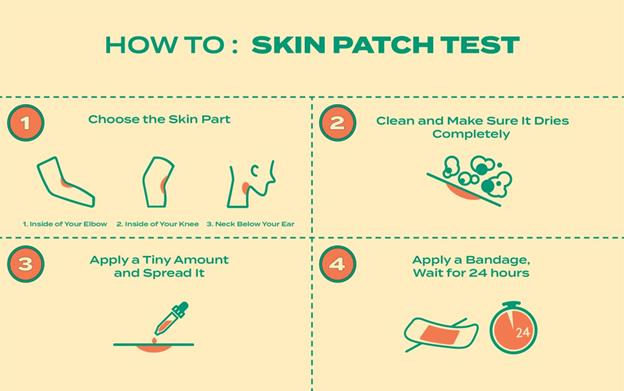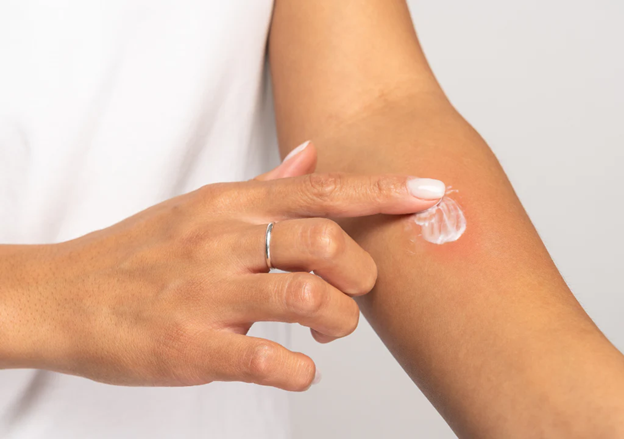Patch testing is a process used to determine whether compounds may cause skin irritation in a given individual. When applied topically, the ingredients in many skin care products can trigger an allergic reaction in some people. A person can find out if a product includes components that could result in a skin reaction by conducting a patch test at home.
Allergies are always a possibility, even with the most natural products. All substances and materials, including man made materials like some forms of plastic and natural ones like pollen, can cause allergies in humans. It’s crucial to conduct a patch test before using any new skincare products to ensure you are not allergic.
What is Patch Test
A patch test is a diagnostic procedure that people can do to find out if using particular goods causes an allergic reaction or just skin irritation. Chemicals, preservatives, perfumes, and cosmetics are just a few of the many things that might trigger a skin reaction.
Applying a little amount of a material or product to the skin and keeping it there to observe if a reaction occurs is known as patch testing.
This is not the same as allergy testing, like a skin prick test. To determine what is causing the symptoms, an allergist will typically do an allergy test, which may result in acute reactions. But it can take days for a patch test to cause skin reactions.
Patch testing a product before using it is advised to reduce the possibility of a severe allergic reaction. Allergies can result in mild redness, uncomfortable swelling, or even worse. Patch testing is crucial since it will enable you to confirm that a new skincare product can be used safely.
How to perform a patch test

- Apply the product to a small patch of skin where a person is unlikely to accidentally wash or rub it away. Good areas may include the inside of the arm or bend of the elbow.
- Apply the product to a quarter-sized patch of skin. A person should apply the product as thickly as they would when using it regularly.
- Leave the product on the patch of skin for as long as it would normally be on the skin. If a person is testing a product that they would usually wash off, such as a cleanser, they should keep the patch on for 5 minutes or as long as the instructions advise.
- Repeat the patch test twice a day for between 7–10 days. A reaction may not happen immediately, so it is important to continue applying the product for this length of time.
- If a person’s skin reacts to the product, they should wash it off as soon as possible and stop using it. A person can use a cool compress or petroleum jelly to relieve the skin if needed.
How to choose a product

Look for labels that state “fragrance-free” while purchasing skin care products to prevent any allergic reactions. Even though some items may say on their labels that they are unscented, fragrances may still be present.
It’s not always a given that ingredients labeled as hypoallergenic, organic, or ideal for sensitive skin won’t produce an allergic reaction. People might prefer to search for goods with the label “free and clear” instead.
Make sure to thoroughly examine product ingredient lists to identify any known allergies.
It should be fairly easy to determine if you are allergic to the product. You could notice some pink or red color from the band aid itself when you initially remove it, but this should go away in a short while. Should the redness not go away, you might have a minor allergy.
It is most likely a serious product allergy if the skin is red, elevated, itchy, or covered in a rash. See your doctor or an allergy specialist if you’re unsure or if you’ve experienced serious reactions to skincare products in the past.
Benefits of Patch Testing
- Prevents irritation and allergic reactions: A patch test aids in the identification of substances that may cause an adverse reaction in your skin, which is typically a normal occurrence. This is especially crucial for people who have sensitive skin or allergies to certain substances, such as essential oils, perfumes, or parabens.
- Promotes a healthy skin microbiome: The delicate ecosystem of bacteria and other microorganisms known as the skin microbiome is essential to preserving the health of the skin. This delicate balance can be upset by harsh reactions to new products, which can cause dryness, inflammation, and an increased risk of breakouts. Patch testing protects your skin microbiome’s integrity.
- Maximizes product effectiveness: When a product reacts badly to your skin, it may not be able to provide the desired effects, like minimizing acne and hydrating the skin. By ensuring that you’re utilizing items that your skin can tolerate, patch testing helps products do their job.
- Saves money and time: Although patch testing may seem like an unnecessary step, it can save you a lot of money on products that you end up throwing away because they irritate you too much. It also spares you the aggravation of handling adverse reactions and the time it takes for your skin to heal.
Why Choose Gangnam Theme Dermatology
One proactive measure to avoid a bad reaction from new skin care products is to conduct at-home patch tests. You might need a more thorough patch test conducted under the supervision of a dermatologist to find out what ingredients in skin care products you’re allergic to or if you’re constantly responding to new ones.
The good news is that you don’t need to handle things by yourself. Theme Dermatology Clinic can be your partner in this journey. Our skilled team of medical professionals at Theme Dermatology Clinic has years of experience treating acne, and they are eager to assist you in getting the skin you’ve always desired. With three board-certified dermatologists with extensive expertise, Gangnam Theme Dermatology is one of the oldest dermatology practices in Gangnam, Seoul, South Korea. It can be found right between Sinnonhyeon and Gangnam Stations, in the center of the famous Gangnam neighborhood.
With an extensive experience of over 20 years in dermatology, our team of specialists is highly regarded for their expertise and unwavering commitment to excellence. Over more than 20 years, the clinic cared for patients with various skin issues and types. They can assist you with acne, pigmentation, anti-aging (lifting), scars, and other skin issues. Also, among Korean clients, they are one of the most well-known skin clinics. The variety of services they offer and their knowledge of skin issues will satisfy you.
Gangnam Theme Dermatology Booking Information
The clinic can be found at 423 Gangnam-daero, Seocho-gu, Hanseung Building, 7th Floor, Seoul, South Korea. To reach out directly, dial +821094839974 on WhatsApp and Kakao. Sending a message to Gangnam Theme Dermatology will allow you to talk about your concerns, make an appointment, or receive an online consultation. Send an email to [email protected]. You can also look through everything and ask questions on the Gangnam Theme Dermatology website by clicking this link: https://themedermatology.com/about-us/


FAQs
A skin test called a patch test is performed to determine what might be causing an allergic reaction on the skin. Allergy contact dermatitis is the name given to this reaction. A reaction to something that came into contact with the skin is known as contact dermatitis. An allergic reaction of this type typically results in inflammation (redness, itching).
Fortunately, you can determine whether you'll have a bad skin reaction by first testing skin care items on a few small parts of your skin.
It is essential that you perform a patch test and document the results on your client's notes in order to avoid falling victim to the patch trap. This gives insurance companies the ability to defend you against claims and show that you have not been careless.
Conclusion
Choosing the best skincare products can be difficult due to the wide variety available, ranging from cleansers to moisturizers. You never know what kind of substance might irritate your skin, even if you are aware of it. Preservatives, for example, are ingredients that can irritate skin and produce allergic contact dermatitis, which manifests as swelling, redness, and itching.
There is an easy fix for this kind of problem: patch testing. In essence, patch testing involves evaluating new items. This seeks to determine whether a certain agent causes contact dermatitis, an allergic skin irritant. Patch testing, as opposed to needle-based allergy tests, entail putting possible allergens on patches that are applied to your skin.

